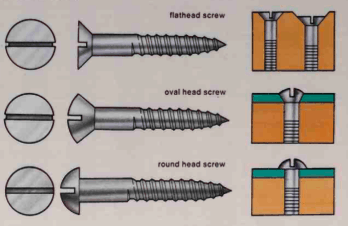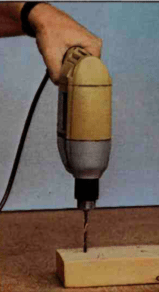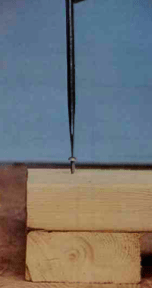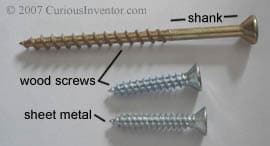Screw Types

Screws provide heavy-duty fastening, are stronger than nails and have the added advantage of being removable. If the proper techniques are followed, wood screws are easy to assemble and will form a tight, permanent join.
Although there are several different types of screws used for specific purposes, the most common wood screw types are the flat head, oval head and round head.
The flat-heaa screw is used where the screw head needs to sit flush with the surface or countersunk slightly below the surface.
Oval-head screws have a tapered body on the bottom of the head, which is sunk into the wood leaving the rounded top of the screw above the surface. These serve a decorative purpose when you want screw heads to be visible and are aiso slightly easier to remove than flat-head screws.
Round-head screws have a flat head base rather than the tapered, countersunk base of the flat and oval screws. This flat base permits the use of washers when necessary, and also allows the use of the screw with thin stock where there isn’t enough room for countersinking.
Most screw types are available with a slotted head, which is the most common type; the cross-slotted or Phillips head, which accepts only the Phillips screwdriver and is de-
signed to minimize the chance of the screwdriver slipping; and, in Canada, the Robertson head, which has a square recess to accept the square head of the Robertson screwdriver. This last type of screw greatly reduces the chance of screwdriver slippage.
Screws are available in a variety of lengths and diameters. Buy the size and type best suited to the job at hand A general rule is to buy a screw three times the length of your thinnest stock so that two-thirds of the screw (the size of the threaded area on the shank) is buried in the base material.
The length of the screw is measured in inches while the diameter is indicated in gauges with 0 (1/16in) gauge being the smallest ana about 24 (3/8in) gauge being the largest. The most useful screw diameters for the homeowner range from 3 gauge to 14 gauge. Screws are available in lengths of 4in, but for fastening anything thicker use a lag bolt, which is fastened with a wrench.
Splitting and binding are common problems if screws are used improperly. Screws need a pilot hole drilled in the wood first to enable the thread of the screw to grip the base wood.
Normally, a clearance hole is drilled completely through the top piece of wood. This hole is equal to the diameter of the threaded portion of the shank and should be wide enough to allow the shank to pass through unimpeded. A pilot hole is then driven into the base wood roughly equal to half the length of the thread on the screw and slightly smaller than the diameter of the thread.
To drill the holes, measure and mark your drill point with an X on the top piece of wood. Drill the hole completely through the wood at the center of the X. If the screw is to be countersunk, drill the wider hole on the surface of the board at this point. Check for depth by dropping the screw in place. Drill deeper if necessary. Line up the top piece of wood with the bottom piece exactly where the screws are to be located. Mark the screw location with an awl. Drill the pilot hole in the base wood, line up the two pieces of wood and fasten with the wood screw.
Although soft woods may only need a pilot hole driven into the top piece of wood, it’s still good practice to drill a clearance hole for a tighter grip. There’s no need to ensure that the screw is threaded through the top piece of wood, since an effective joint is one where the thread is buried in the base wood.
FASTENING SCREWS

1 When screwing into wood, a clearance hole is first drilled through the top piece of wood. The hole should have the same diameter as the screw thread

2 A pilot hole is driven into the base wood; the screw is dropped through the clearance hole in the top p<ece and screwed only into the base wood for an effective joint.
